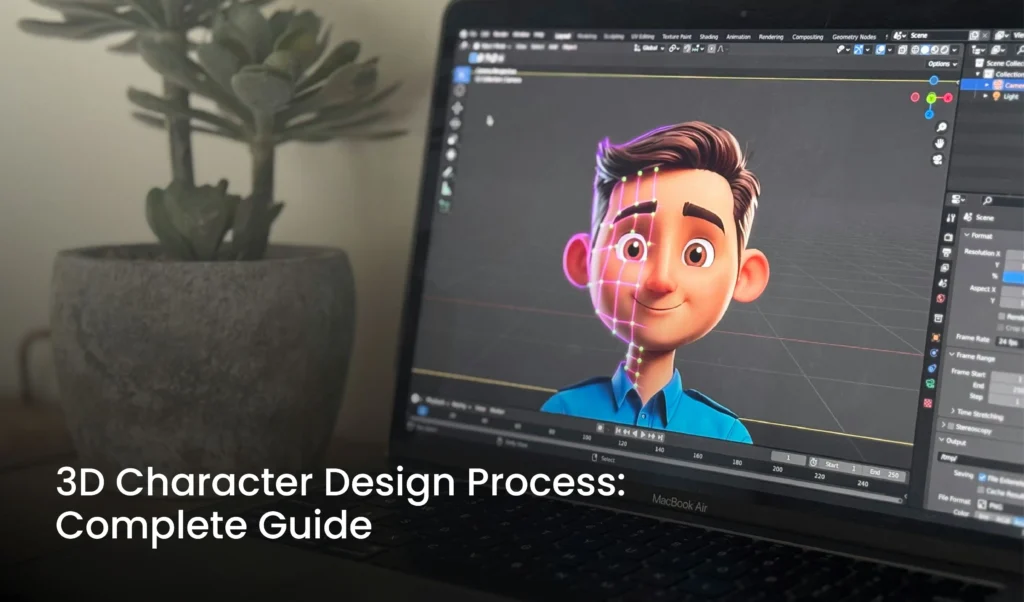Creating a compelling 3D character is both a technical and artistic journey. Whether you’re developing for video games, animations, or branding, the 3D character design process is the backbone of bringing imaginative figures to life. In this guide, we’ll walk you through each stage of building a unique and engaging 3D character from concept art to final model.
If you’re wondering how to make 3D characters for games or searching for the right partner for your project, you’re in the right place.
What Is the 3D Character Design Process?
3D character design is the process of creating digital characters that appear three-dimensional on screen. These characters are used in games, films, animations, simulations, and marketing content. Unlike 2D illustrations, character designs involve modeling, texturing, rigging, and sometimes animating for full interactivity.
Why Is the 3D Character Design Process Important?
A well-designed 3D character does more than look good. It supports storytelling, enhances user interaction, and strengthens brand identity. Every small decision in the character design process, from the character’s silhouette to the colour palette, shapes the viewer’s emotional response.
Need an expert touch? Discover why Innova Designz is the best character designer for unique visuals.
Step-by-Step: The Complete 3D Character Design Process
1. Concept and Research
Every great design starts with a great idea. In the first stage, the artist focuses on brainstorming, mood boards, and sketches.
- Study the character’s role in the story or game.
- Define the target audience.
- Gather references for style, posture, and costume.
Key Term: 3D character concept art is a critical early step, giving shape to ideas before modelling begins.
2. Character Design and Development
This is where creativity meets structure. The artist creates detailed 2D drawings from various angles.
- Silhouette exploration: Establishes the character’s unique form.
- Colour exploration: Reflects personality and mood.
Wondering which is the second step in visual character development? It’s this stage, the visual refinement of the initial idea.
3. Modelling the Character in 3D
This is when the character transforms from sketch to sculpture.
- Use software like Blender, Maya, or ZBrush.
- Start with basic shapes and refine to high-poly detail.
- Optimise for game engines if necessary.
This is known as creating 3D characters, where 2D visuals become interactive, animated figures.
If you’re curious how to make a 3D character model, this step includes digital sculpting and mesh creation. Learn more about 3D Character Art Services at Innova Designz.
4. Texturing and Materials
After modeling, textures bring your character to life with colour, fabric, skin, and metal effects.
- UV unwrapping to lay out the model’s surface.
- Paint or bake textures with software like Substance Painter.
- Apply materials for realistic effects like gloss, roughness, or subsurface scattering.
Texturing is what separates a plastic-looking model from a believable, breathing character.
5. Rigging and Skinning
To move a character, you must build its internal structure.
- Rigging: Add bones and joints.
- Skinning: Attach the mesh to the skeleton for natural movement.
Whether you’re designing a 3D character for a game or an animation, this stage is crucial for interactivity.
6. Animation
If the character is meant to walk, talk, or fight, animation is next.
- Add poses and actions.
- Use keyframe animation or motion capture data.
- Test movements in-engine for fluidity.
7. Final Rendering or Game Engine Integration
Depending on the end goal:
- For games: Export the character into the game engine with animations and textures.
- For films/ads: Render the final images with lighting and background.
This wraps up the full character modeling for games or cinematic use.
Common Tools Used in the Character Design Process
| Tool | Use case |
| ZBrush | Sculpting High-Poly Models |
| Blender | Modeling, Rigging, Animation |
| Maya | Advanced Rigging & Animation |
| Substance Painter | Texturing |
FAQs About 3D Character Design
Q1: How to make a character model if I’m a beginner?
Start with basic modeling software like Blender. Focus on learning low-poly characters and gradually explore sculpting tools.
Q2: Can I use 3D characters in mobile games?
Yes, but the models need to be optimized with fewer polygons and lightweight textures.
Q3: How long does it take to create a 3D character?
Depending on complexity, it can take anywhere from 20 hours to several weeks.
Tips for Creating 3D Characters That Stand Out
- Focus on originality in the 3D character concept art phase.
- Pay attention to proportion and anatomy.
- Don’t neglect texture, it adds realism.
- Always test your character in the target environment.
Who Are 3D Character Designers and Character Modelers?
3D character designers are visual storytellers who create the concept and visual style. Character modelers bring these designs into the 3D world through digital sculpting and mesh modeling.
At Innova Designz, our team combines both skills to deliver characters that not only look stunning but also function flawlessly in any medium.
Why Choose Innova Designz for 3D Character Design?
With years of experience in making 3D characters for AAA games, indie films, and digital marketing, we understand what it takes to make a character truly shine. We follow all essential character design steps, offer tailored solutions, and collaborate with clients closely.
Need characters that tell stories? Explore our 3D Character Art Services or Innova Designz: The Best Character Designer for Unique Visuals to see how we bring ideas to life.
Final Thoughts
The 3D character design process blends imagination, technical expertise, and strategic planning. From early sketches to fully rigged models, every stage requires attention to detail. If you’re looking to design 3D characters that engage audiences and elevate your content, partner with experts who understand the art and science of character creation.
Let Innova Designz transform your ideas into unforgettable 3D characters.


